& Construction

Integrated BIM tools, including Revit, AutoCAD, and Civil 3D
& Manufacturing

Professional CAD/CAM tools built on Inventor and AutoCAD

Integrated BIM tools, including Revit, AutoCAD, and Civil 3D

Professional CAD/CAM tools built on Inventor and AutoCAD
Any referenced datasets can be downloaded from "Module downloads" in the module overview.
Transcript
00:00
INSTRUCTOR: Hi there.
00:01
In this video, we will be checking and validating
00:04
potential alternatives to the existing network of our road
00:07
and highway project.
00:09
This is where we are on the overall view
00:11
of the analysis in civil engineering learning path.
00:18
Before proposing new alternatives,
00:19
we will align the model that we will
00:21
use as the base for the rest of the proposals, PO1A.
00:26
To do so, we will remove all the sources
00:28
that are not relevant to our goal, which means buildings,
00:32
city furniture, and railways, leaving the ground imagery,
00:35
the roads, and the terrain.
00:38
Cleaning out the PO1A model will allow
00:40
us to regenerate the proposals quicker,
00:42
making it easy to undo or redo our model.
00:53
Let's now switch on the TSA, focus on the TSA4,
00:57
and run the long morning simulation.
00:60
We can observe that the level of service
01:02
is not unmissable for the delay threshold allowed
01:04
by the local authorities.
01:07
All intersections have delays above 35 seconds.
01:11
This is the East intersection which
01:13
crosses the two freeways within the area,
01:15
and it has an average delay of 81 seconds.
01:19
The South intersection is the only one
01:21
that is not signalized, meaning it does not have lights
01:24
controlling the intersection.
01:26
Having into account that the initial information,
01:29
the intention of the alternatives to be proposed
01:31
is to reach a good level of service
01:33
with delays below 35 seconds.
01:36
This is the first alternative proposed, PO1A roundabout.
01:42
As you see, the West intersection
01:44
which was signalized has been replaced by a roundabout.
01:48
After running the long morning simulation
01:50
with the same demands and TSA details
01:53
that the ones used for the original PO1 proposal,
01:57
we can observe that far from reducing
01:59
the delays in the network, we have increased them by 10.
02:04
The current arrangement starts collapsing
02:06
the East intersection, forming a queue
02:09
towards the newly installed roundabout that
02:12
ends up collapsing the roundabout as well.
02:15
Once the roundabout is collapsed,
02:16
the nearby demand zones are reached by the queues,
02:20
and we can spot failures in the simulation
02:22
with cars overlapping or moving in a strange way.
02:29
Straight away, without a single doubt,
02:31
we can obviously state that the PO1A roundabout proposal is not
02:36
a feasible alternative.
02:44
The next alternative proposed is called PO1A roundabout 1.
02:49
The new proposal substitutes designalized East intersection
02:53
with another roundabout, keeping the West roundabout
02:57
from the previous proposal.
02:59
After running the long morning simulation
03:01
on our traffic simulation asset card
03:04
the simulation results displayed on the canvas
03:07
show acceptable delays and levels
03:09
of service on the TSA full network analysis.
03:13
In order to validate our findings,
03:15
let's make sure that the demand matrix data is the same on this
03:19
and the original PO1 proposal.
03:32
Now that the validation has been confirmed,
03:35
let's try to find a way to polish our proposal winner,
03:38
PO1 roundabout 1.
03:42
The intention of the PO1 roundabout proposal
03:45
is to reduce risks on this South unsignalized intersection.
03:52
Bearing in mind the arrangement you can see,
03:54
the intention is to add two auxiliary lanes--
03:58
that has been done already--
03:60
then, force the second lane from the exterior
04:03
of the road 3 North a mandatory right turn into road 9.
04:08
Then force the other two lanes of the road
04:10
to the North to only go straight because that combined will
04:15
allow it to have a freeway or a yield control to the road
04:25
To start, lets force the second lane from the exterior through
04:34
That's done.
04:35
Now we're going to open tab and check the specific and detailed
04:40
behavior of each lane.
04:44
So far, everything looks fine.
04:46
The arrows are pointing to the correct direction,
04:48
but let's check the intersection.
04:51
To start, the road
04:54
controlled by a stop sign.
04:56
Given that the two internal street
04:58
lanes of the road 3 North are splitting in 4
05:01
to the intersection, we want amend the behavior
05:04
to allow the freeway proposed for the lanes coming
05:07
from the road number 9.
05:09
Once this is done, we can enable the freeway for the road
05:15
sign for the lane turning left.
05:24
After syncing to the cloud from tap, back in Infoworks,
05:29
we can run the simulation again and check how it looks like.
Video transcript
00:00
INSTRUCTOR: Hi there.
00:01
In this video, we will be checking and validating
00:04
potential alternatives to the existing network of our road
00:07
and highway project.
00:09
This is where we are on the overall view
00:11
of the analysis in civil engineering learning path.
00:18
Before proposing new alternatives,
00:19
we will align the model that we will
00:21
use as the base for the rest of the proposals, PO1A.
00:26
To do so, we will remove all the sources
00:28
that are not relevant to our goal, which means buildings,
00:32
city furniture, and railways, leaving the ground imagery,
00:35
the roads, and the terrain.
00:38
Cleaning out the PO1A model will allow
00:40
us to regenerate the proposals quicker,
00:42
making it easy to undo or redo our model.
00:53
Let's now switch on the TSA, focus on the TSA4,
00:57
and run the long morning simulation.
00:60
We can observe that the level of service
01:02
is not unmissable for the delay threshold allowed
01:04
by the local authorities.
01:07
All intersections have delays above 35 seconds.
01:11
This is the East intersection which
01:13
crosses the two freeways within the area,
01:15
and it has an average delay of 81 seconds.
01:19
The South intersection is the only one
01:21
that is not signalized, meaning it does not have lights
01:24
controlling the intersection.
01:26
Having into account that the initial information,
01:29
the intention of the alternatives to be proposed
01:31
is to reach a good level of service
01:33
with delays below 35 seconds.
01:36
This is the first alternative proposed, PO1A roundabout.
01:42
As you see, the West intersection
01:44
which was signalized has been replaced by a roundabout.
01:48
After running the long morning simulation
01:50
with the same demands and TSA details
01:53
that the ones used for the original PO1 proposal,
01:57
we can observe that far from reducing
01:59
the delays in the network, we have increased them by 10.
02:04
The current arrangement starts collapsing
02:06
the East intersection, forming a queue
02:09
towards the newly installed roundabout that
02:12
ends up collapsing the roundabout as well.
02:15
Once the roundabout is collapsed,
02:16
the nearby demand zones are reached by the queues,
02:20
and we can spot failures in the simulation
02:22
with cars overlapping or moving in a strange way.
02:29
Straight away, without a single doubt,
02:31
we can obviously state that the PO1A roundabout proposal is not
02:36
a feasible alternative.
02:44
The next alternative proposed is called PO1A roundabout 1.
02:49
The new proposal substitutes designalized East intersection
02:53
with another roundabout, keeping the West roundabout
02:57
from the previous proposal.
02:59
After running the long morning simulation
03:01
on our traffic simulation asset card
03:04
the simulation results displayed on the canvas
03:07
show acceptable delays and levels
03:09
of service on the TSA full network analysis.
03:13
In order to validate our findings,
03:15
let's make sure that the demand matrix data is the same on this
03:19
and the original PO1 proposal.
03:32
Now that the validation has been confirmed,
03:35
let's try to find a way to polish our proposal winner,
03:38
PO1 roundabout 1.
03:42
The intention of the PO1 roundabout proposal
03:45
is to reduce risks on this South unsignalized intersection.
03:52
Bearing in mind the arrangement you can see,
03:54
the intention is to add two auxiliary lanes--
03:58
that has been done already--
03:60
then, force the second lane from the exterior
04:03
of the road 3 North a mandatory right turn into road 9.
04:08
Then force the other two lanes of the road
04:10
to the North to only go straight because that combined will
04:15
allow it to have a freeway or a yield control to the road
04:25
To start, lets force the second lane from the exterior through
04:34
That's done.
04:35
Now we're going to open tab and check the specific and detailed
04:40
behavior of each lane.
04:44
So far, everything looks fine.
04:46
The arrows are pointing to the correct direction,
04:48
but let's check the intersection.
04:51
To start, the road
04:54
controlled by a stop sign.
04:56
Given that the two internal street
04:58
lanes of the road 3 North are splitting in 4
05:01
to the intersection, we want amend the behavior
05:04
to allow the freeway proposed for the lanes coming
05:07
from the road number 9.
05:09
Once this is done, we can enable the freeway for the road
05:15
sign for the lane turning left.
05:24
After syncing to the cloud from tap, back in Infoworks,
05:29
we can run the simulation again and check how it looks like.
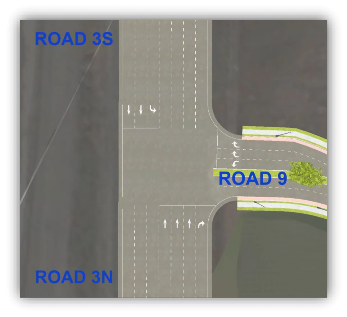
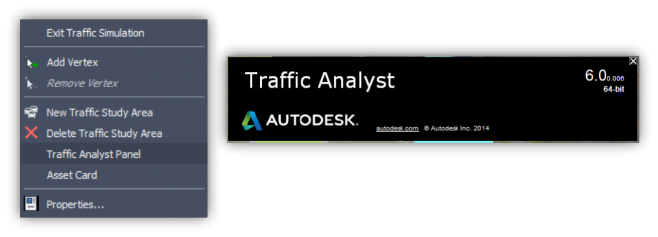
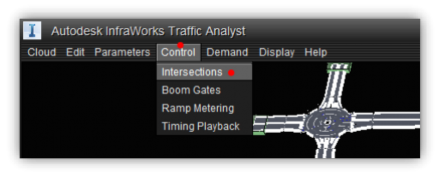
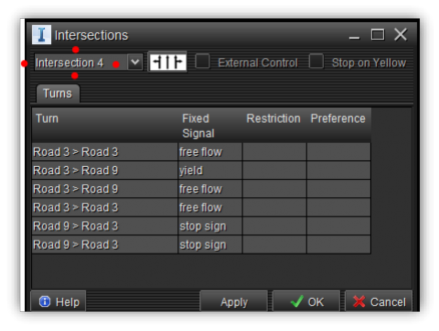
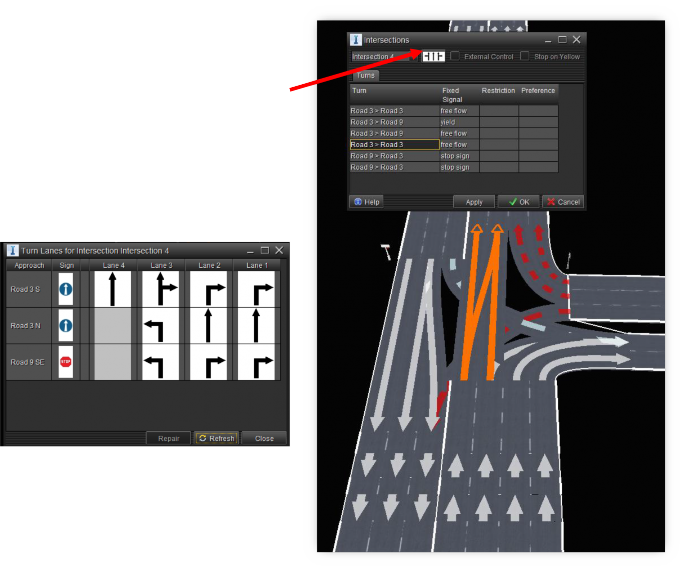
How to buy
Privacy | Do not sell or share my personal information | Cookie preferences | Report noncompliance | Terms of use | Legal | © 2025 Autodesk Inc. All rights reserved
Sign in to start learning
Sign in for unlimited free access to all learning content.Save your progress
Take assessments
Receive personalized recommendations
May we collect and use your data?
Learn more about the Third Party Services we use and our Privacy Statement.May we collect and use your data to tailor your experience?
Explore the benefits of a customized experience by managing your privacy settings for this site or visit our Privacy Statement to learn more about your options.